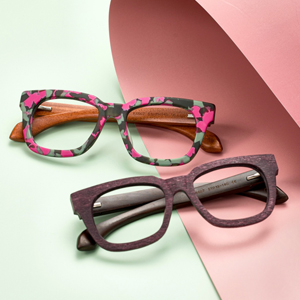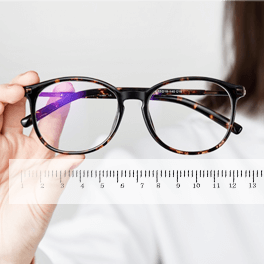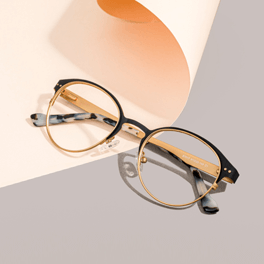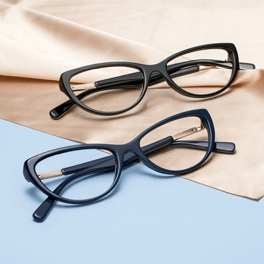FAQ
Quick Links
Adjusting to New Glasses
The right pair of glasses should sit comfortably on the bridge of your nose. They shouldn't press against your eyebrows or cheeks but shouldn't rest so far towards the end of your nose that they slip when you squint or wrinkle your nose or keep slipping when you look down.
Your eyes should be directly in the center of the lens, from left to right, and fill the top half of the lens. The bottom of the eye should roughly touch the vertical midpoint of the lens.
What does it mean if your glasses feel crooked?
Most people have crooked eyebrows, which can make your glasses appear crooked. Check the straightness of your glasses by looking at the bottom of your eyes, not your eyebrows. Sometimes, people's ears don't line up, which could also cause glasses to feel crooked.


Everyone who wears glasses will likely experience the glasses misaligned after you've worn them for a while. Misalignment can be caused by dropping or bumping your glasses, heat deformation, or sometimes just natural deformation. Taking glasses to an optical store to get them adjusted will cost you more time and money. Self-adjusting your glasses is a valuable skill appropriately.
Frames have different adjustment methods due to their material. You need to know the material characteristics before you start to adjust them.
For Plastic Frames
Plastic frames are not very pliable at room temperature. Due to their elastic nature, adjusting plastic frames can be more difficult than metal frames. They're likewise more difficult to deform than metal frames. You can warm up the frames before adjusting them. But you should avoid running warm water over your lenses.
Basic steps:
Step 1: Run the temple arms under warm water (90℉-110℉/32℃-43℃) for at least 30 seconds.
Step 2: Apply LIGHT pressure to the area where you need to adjust.
Step 3: Try your glasses on after each adjustment before making more adjustments.
Step 4: Place your glasses on the table to check if they sit stably and if the temple arms are adjusted consistently.
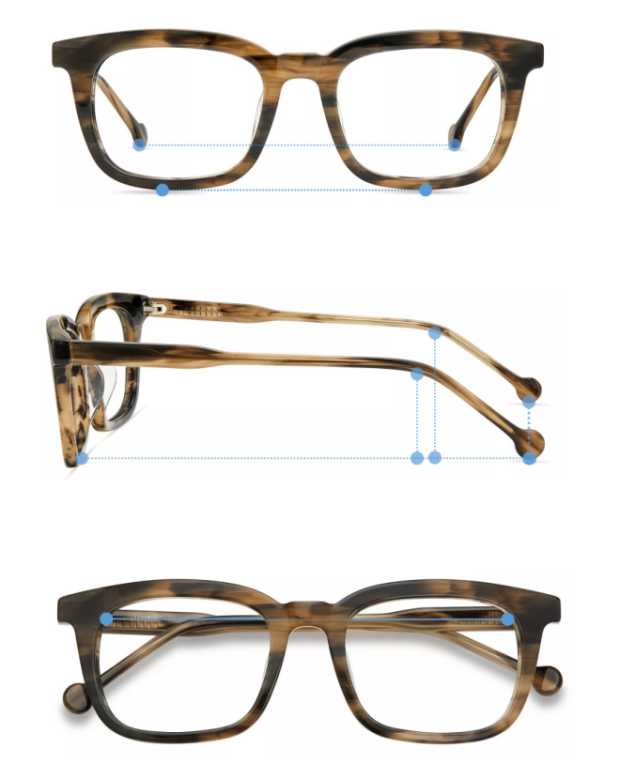
Helpful tips:
◊ Warm water is around 90℉(32℃) and not above 110℉(43℃). DO NOT use boiling water.
◊ Avoid running warm water over the lenses, as it can affect the lens coatings.
◊ Adjust frames a little at a time to avoid overcompensating.
◊ Make sure to try your glasses on after each adjustment.
For Metal Frames
Metal frames do not require heat to adjust them but may require frequent adjustments since some metals used to manufacture eyeglasses are easily bent through daily activity.
Basic steps:
Step 1: Apply LIGHT pressure to the area where needed until a noticeable change is made.
Step 2: Try your glasses on after each adjustment before making more adjustments.
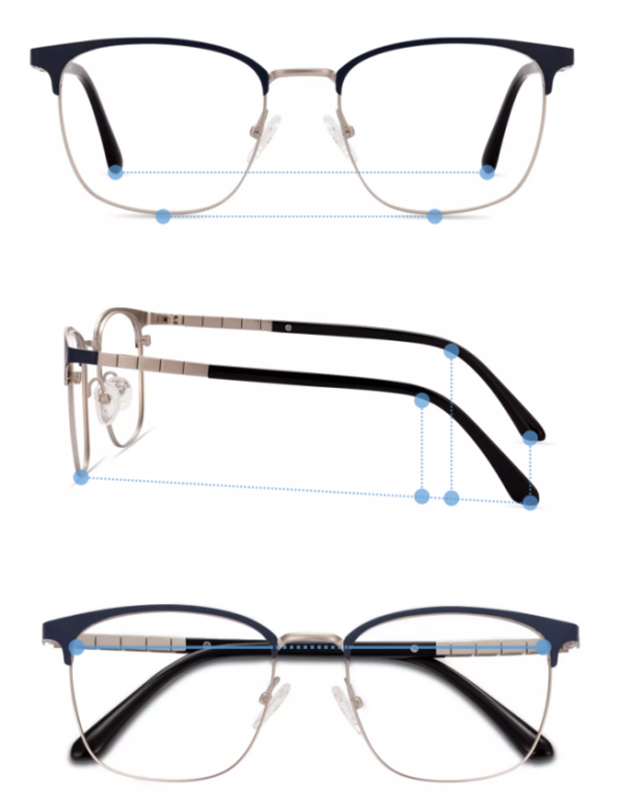
Helpful tips:
◊ Adjust frames a little at a time to avoid overcompensating.
◊ Make sure to try your glasses on after each adjustment.
HOW TO ADJUST THE FRAMES IF
1. Pinching Your Nose/Ears/Head
FOR PLASTIC FRAMES:
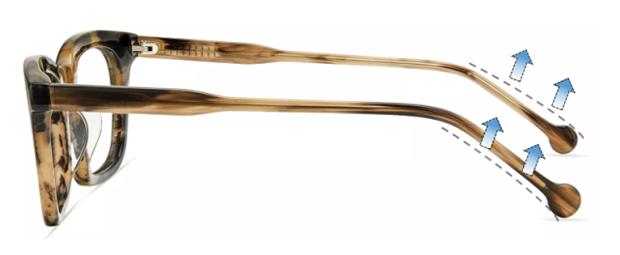
Grip each temple arm and slightly bend upward and outward at where it crosses over your ear to achieve a relaxed fit behind your ears.
The angle of each temple arm should be the same.
FOR METAL FRAMES: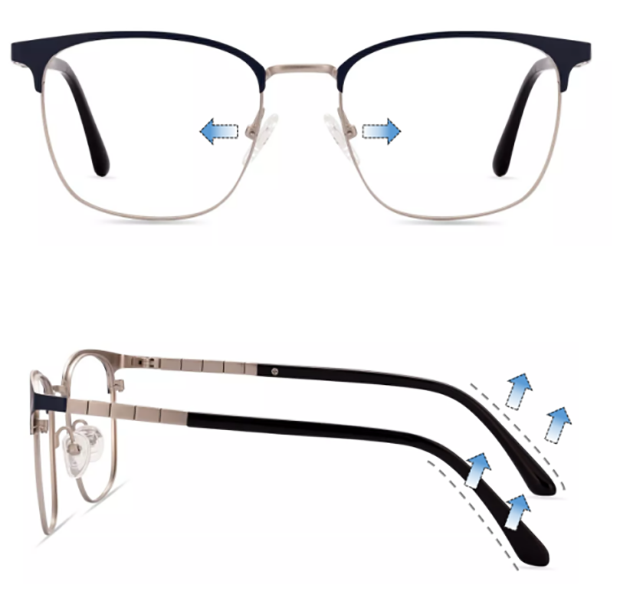
Push the nose pads outward until they fit comfortably.
The angle of each nose pad should be the same.
Grip each temple arm and slightly bend upward and outward at where it crosses over your ear to achieve a relaxed fit behind your ears.
The angle of each temple arm should be the same.
2. Slipping Down Your Face
FOR PLASTIC FRAMES:
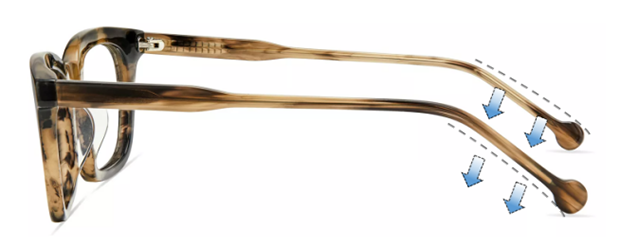
Grip each temple arm and slightly bend downward and inward at where it crosses over your ear to achieve a tighter fit behind your ears.
The angle of each temple arm should be the same.
FOR METAL FRAMES:

Push the nose pads inward until they fit comfortably.
The angle of each nose pad should be the same.
Grip each temple arm and slightly bend downward and inward at where it crosses over your ear to achieve a tighter fit behind your ears.
The angle of each temple arm should be the same.
3. One Lens is Higher Than the Other
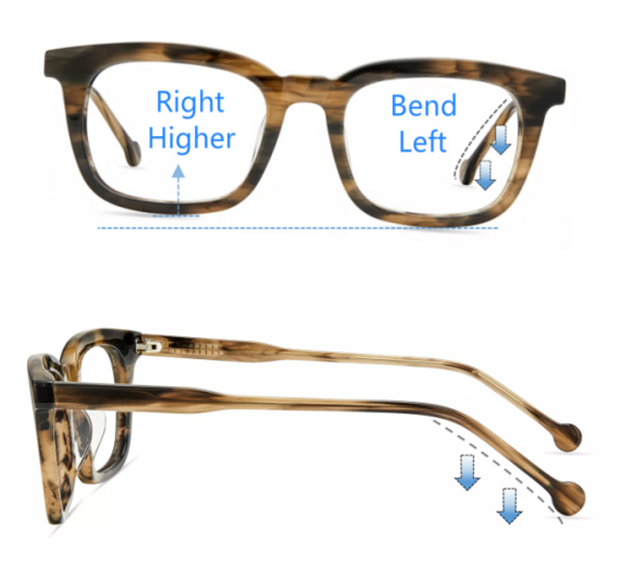
Bend the opposite temple arm slightly at where it crosses over your ear downward to keep the height of the two lenses consistent.
The angle of each temple arm should be the same.
4. One Lens is Closer to Your Eye Than the Other

Bend that lens's arm slightly at where it crosses over your ear inward and the opposite arm outward to keep the distance consistent.
The angle of each temple arm should be the same.
The answer is not for sure because many factors would affect the comfort of wearing new glasses. If your eyes are good at adjusting to new glasses, you may not feel any discomfort.
However, most people do feel uncomfortable when wearing a pair of new glasses, especially with an updated strength of prescription or a frame much bigger or smaller than your old ones.
The common issues you may experience when getting new glasses include:
√ Eye strain: Your eyes may feel tired and sore, especially for the first several days.
√ Blurry vision: You may not focus well on seeing clear.
√ Distortion: Objects may appear slightly warped, bent, wavy.
√ Depth perception: You may have trouble determining how near or far objects are.
√ Fishbowl effect: Objects may seem bent at the edges, like seeing through a fishbowl.
√ Headaches and nausea: Symptoms above can cause headaches, dizziness, and nausea.
In most cases, the more you wear your new glasses, the faster you'll get used to them. It usually takes one or two weeks to adjust (one more week for bifocals and progressive).
Whether you are a first-time eyeglasses wearer or someone who has worn glasses for years, you may find that new glasses do not seem to work well with your eyes. You may experience some common discomforts, such as blurred vision, dizziness, headache, eye strain.
It is necessary to know that your eyes have to adjust after you get your new glasses. It is called an adjustment period.
Don't get discouraged and switch to your old glasses if you have these sensations with your new glasses right now. You will get perfect vision with your new glasses if you wear them consistently to adjust.
For single-vision glasses wearer (to see far away or up close), it takes one week to subside the discomfort. If you have a strong prescription, a two-week adjustment period may be necessary.
1. Put your new glasses on as soon as you wake up and wear them as much as you can each day.
2. Don't go back and forth with your old glasses, even if your old pair is more comfortable.
3. Hide your old glasses if you have to!
Your vision may change as you age. You'll know it's happening when have to hold farther away just to read it. This is called presbyopia. It's normal, and almost all of us get it as we reach the middle 40's.
Reading glasses can help read clearly. But if you want to see clearly at a different distance in just one pair of glasses, then bifocals or progressive glasses may do the trick. They're also called multifocal glasses.
Bifocals have two fields of vision: the upper for distance and the lower for up close. There is a visible line across the middle that divide the two corrections.
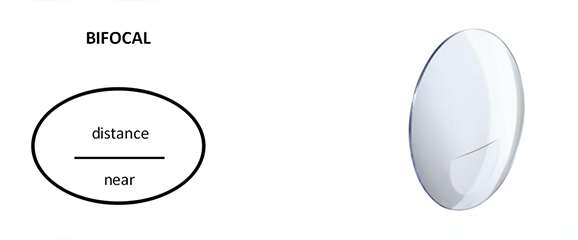
Progressives have a gradual or progressive change in vision in different parts of the lens, so there's no visible line on the lenses.
Progressive lenses have three fields of vision and tend to be blurry on the sides of the lens. You see far away through the upper lens and up close through the lower. The intermediate-range of the lens is used to see your laptop or something in the range of 20 inches to 40 inches (50 cm - 100cm) away from your eyes.
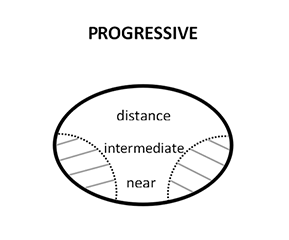
Short-Term Side Effects
You may need some time to adjust to your multifocals. Most people get used to them after a week or two, but it can take longer. A few people never like the changes in vision and give up on bifocals or progressives.
At first, you may notice these:
• Blurry vision
• Objects that seem to jump or move around
• Headaches
• Nausea
• Balance problems
Bifocals or progressives may change the way you judge distance or depth as you look down through the bottom of the lens. So it takes a longer adjustment period than single vision glasses.
How to Adjust
Don't give up on your new lenses. Take these steps to get used to them, and you will enjoy a clear vision with bifocals and progressives.
1.Try putting on bifocals or progressives first thing in the morning and wear them for just an hour or two. The next morning, try a few more hours. Slowly build up your tolerance to adjust to them.
2.Don't switch between your new glasses and your old ones.
3.Make sure your new eyeglasses fit properly and don't slide down your nose.
4.When you walk, look straight ahead, not down at your feet. Also work on pointing your nose in the direction you want to look, not just looking left or right with your eyes. You cannot see clearly through the peripheral lenses.
5.When you read, hold the items down and about 16 inches away from your eyes. Look through the bottom of your lenses. (the bottom is for reading)
6.Don't move your eyes or head while you read. Move the page or paper instead.
7.Set your computer screen just below eye level. You can adjust your desk or chair.
8.Talk to your eye doctor if your lenses still bother you after a few weeks. You may need to change your prescription strength.
Most issues related to adjusting to new glasses resolve on their own after a few days, but for some people, the adjustment period can take more than two weeks.
It takes one or two weeks to get used to your single-vision glasses.
It usually takes two or three weeks for multifocal glasses wearer because the lenses are designed for different fields of vision on one lens.
*Click here to know how to adjust to single vision glasses.
*Click here to know how to adjust to multifocal glasses.
Most people experience discomfort from the new glasses. It is common for them to have an adjustment period. The best and only way to get used to new glasses quickly is by wearing new glasses whenever possible. The more you wear your new glasses, the faster you'll get used to them.
It is common to feel dizzy while wearing a pair of new glasses, especially when you get a new prescription, multifocal lens, and astigmatism. Even if your prescription and lens stay the same, the difference in the frame's shape and lens material can throw your eyes off. Under this situation, it usually takes one or two weeks to adjust to the new glasses.
Luckily, as your eyes begin to adjust to the new glasses, the dizzy feelings will be gone.
It is especially obvious when you are getting a new prescription or a new frame much larger or smaller than your old ones. Even for the new glasses with the same prescription in a similar size, your eyes have to adjust to the new situation of the lens to see it clearly and perfectly.
It's not unusual to have a headache the first several days you wear your new prescription glasses, but it subsides after a one-week adjustment period. The progressive or bifocal lens would have a longer adjustment period that is mostly two or three weeks.
Most people will experience strained and sore eyes during the first few days, even for people who have worn glasses for years. There would be a slight adjustment period that usually takes one or two weeks. The adjustment period for the multifocal lens is a bit longer which is generally two or three weeks.
It is a common issue that you may experience blurriness or distortion with new prescription glasses. It is your eyes getting used to your new glasses and can lead to temporary discomfort. Relax. One or two-week adjustment would get you a clear and perfect vision. One more week for the multifocal lens are necessary.
Besides, if you start to wear progressive lenses or bifocals for the first time, you may need to learn how to focus your vision through the multifocal lens as well.
Bifocals have two fields of vision: the upper for distance and the lower for up close.
Progressive lenses have three fields of vision and tend to be blurry on the sides of the lens. You see far away through the upper lens and up close through the lower. The intermediate-range of the lens facilitates a change in lens strength, and it is for seeing your laptop or something in the range of 20 inches to 40 inches (50 cm - 100cm) away from your eyes.
*Click here to know how to adjust to single vision glasses.
*Click here to know how to adjust to multifocal glasses.
What you're seeing may be bent along the edges with your new glasses as if seeing the world through a fishbowl. This feeling is called the 'fishbowl effect' in the optical world. It may take you one or two weeks to go through it. Also, you may need to focus your vision right through the center of the lens, not the edge of the lens. The correct point of your focus can greatly ease the discomforts.
New glasses with the same prescription may feel weird sometimes, even when the prescription hasn't changed. Several factors may affect the way how you feel with your new glasses, such as the difference in your frame's shape, lens material, prescription strength. Fortunately, it just takes you one or two weeks to adjust to your new glasses (one more week for the multifocal wearer).
Any difference between your new glasses and old ones can make you feel your prescription off sometimes. For this matter, it usually takes one or two weeks to adjust to the new glasses (two or three for multifocal).
But what if your eyes will not adjust to your new glasses even after an adjustment period? The potential problem is the incorrect prescription.
Errors of a prescription can occur during your eye examination, where your eye care provider interprets your answers about what you can and can't see. If you have the eye exam after work, when your eyes are tired and strained, it could skew the results of the exam.
For this matter, you need to go back to your eye care provider and request a double-check of your prescription.

